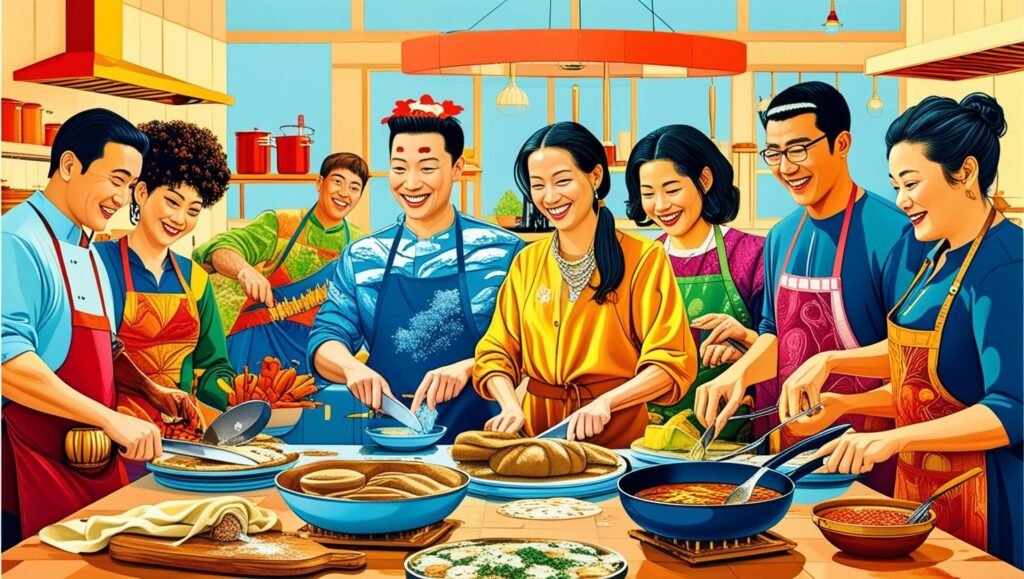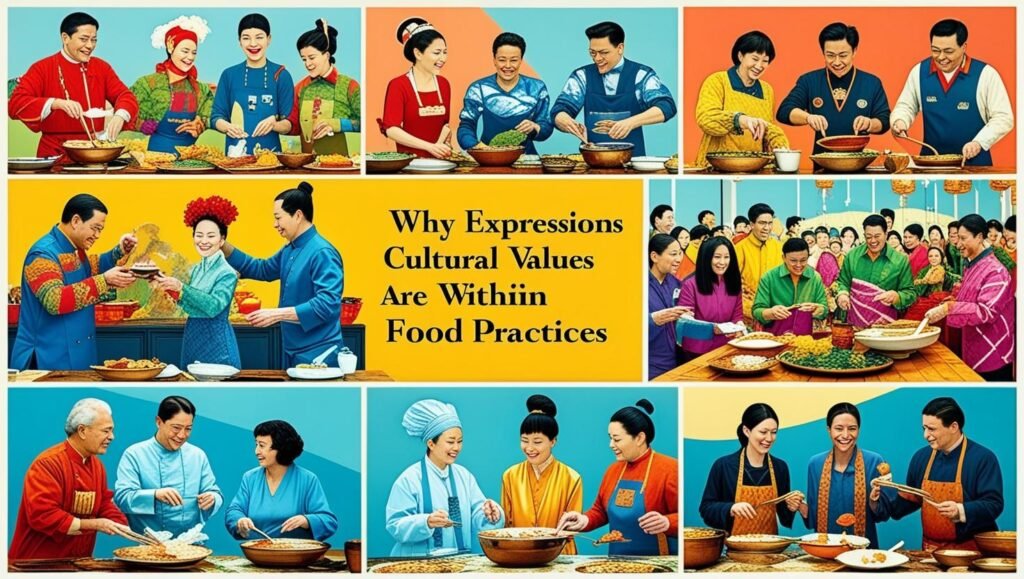Food tells stories that words cannot express. People gathering at tables throughout the Asian Pacific Rim find that their culinary traditions share surprising connections, despite apparent differences.
The Asian/Pacific Rim region’s cultural contrasts and similarities emerge through its distinct foodways. Centuries of shared history, trade, and tradition have shaped these connections. The steam wafting from Hong Kong’s dim sum and Thailand’s aromatic curries shows common threads running through these regions.
Ancient trade routes have molded our cuisines. Geography has left its mark on food traditions, while shared cooking techniques unite our culinary heritage. This trip shows how food serves as more than sustenance. It mirrors our shared cultural values and unique identities.

Historical Influences on Asian Pacific Foodways
Asian Pacific food culture traces its roots to ancient maritime routes that connected distant shores. The Spice Routes stretched over 15,000 kilometers from Japan’s west coast through Indonesia and around India to the Middle East. These routes shaped our earliest culinary exchanges 1.
Ancient trade routes and ingredient exchange
The scope of ingredient movement along these routes was remarkable. Cinnamon from Sri Lanka and cassia from China made their way to the Middle East as early as 2000 BC 2. These trading networks became more than spice exchanges. They turned into cultural hubs where people shared culinary knowledge, religious beliefs, and cultural practices.
Colonial impacts on local cuisines
Traditional foodways changed when colonial powers arrived. Pacific Islands’ indigenous diet before colonization included:
- 85% vegetable-based foods
- 10-15% protein (primarily from seafood)
- 60-78% carbohydrates 3
Southeast Asian cuisine changed with colonial influence. French staples like coffee, bread, pate, and pastries became dietary norms in Vietnam, Cambodia, and Laos 4. The Dutch presence affected Indonesian cuisine differently. The Dutch adopted Indonesian dishes instead of imposing their own 4.
Modern fusion and evolution
Asian Pacific cuisines continue to evolve. Modern chefs create what’s known as cuisine moi (new Vietnamese cuisine). They blend global influences with traditional techniques 5. This modern approach shows how our relationship with food traditions has changed. We now balance cultural heritage preservation with innovation and cross-cultural exchange.

Geographic and Climate Factors
The Asian Pacific Rim offers a captivating look at how geography shapes our food traditions. People’s eating habits and food choices reflect their location, whether they live in coastal areas or inland settlements.
Coastal vs inland food traditions
Coastal communities enjoy the advantage of abundant fresh seafood that serves as the foundation of their local cuisine. These regions have built their culinary identity around fishing as their primary food source 6. Research shows that coastal food imports often cost less than inland-sourced food, particularly in areas with poor infrastructure 7.
Seasonal ingredient availability
The region’s agricultural patterns show that summer season rainfall (November-April) benefits about 70% of the cropped area 8. This creates unique patterns in food availability and traditions. Korean and Japanese cuisines showcase this beautifully, as ingredients like myoga ginger and chrysanthemum become sought-after delicacies during specific seasons 9.
Agricultural practices and staple crops
The agricultural landscape demonstrates incredible variety, though rice remains the dominant crop. Asia produces 90% of the world’s total supply 10. Local farmers have adapted their methods to various conditions:
- Traditional irrigation methods rely on gravity water flow from upstream reservoirs
- Modern high-yielding cereal strains have improved productivity since the 1960s
- The black-earth belt across southern Siberia specializes in wheat production 10
Climate change affects traditional growing patterns while rapid urbanization alters our connection with agriculture 11. Communities continue to adapt by finding new ways to preserve their distinct foodways while welcoming modern agricultural advances.

Shared Cooking Techniques
Asian Pacific communities share timeless cooking techniques that are the foundations of our cuisine. These methods help us preserve food and create the unique flavors that make our dishes special.
Steam cooking across cultures
Steaming remains one of our most treasured cooking methods. We’ve refined this technique with water heated to 212 degrees Fahrenheit 12. The gentle vapor keeps nutrients intact and brings out natural flavors. Our traditional bamboo steamers have become essential tools, especially when making dim sum, wontons, and various dumplings 13.
Steam cooking offers these benefits:
- Keeps vitamins and minerals intact
- Needs less added fats
- Makes food colors more vibrant 13
Fermentation practices
Fermentation blends art and science in our culture, with roots going back to 5000 BCE 14. Southeast Asian communities make fermented foods at home or in villages 15. Simple ingredients become complex flavors through fermentation – from fish sauce to kimchi and fermented vegetables 14.
Use of marine ingredients
Our coastal roots gave us deep knowledge of ocean ingredients. We make the most of everything from seaweed to countless fish varieties. Wakame, a Pacific Ocean seaweed, shows our expertise – it works beautifully in soups, salads, and alongside tofu dishes 16. Marine ingredients do more than feed us – they add natural depth to our broths and seasonings 17.

Cultural Values in Food Practices
Food serves as our language of love and connection in Asian Pacific communities, going beyond basic sustenance. “Food brings us all together,” which shows clearly in Chinese families gathering around round tables to share meals and strengthen their bonds 18.
Family and communal dining
Chinese households demonstrate strong cultural values through communal dining. The use of gong kuai (public chopsticks) and gong shao (public spoons) lets family members serve each other as a gesture of respect and care 19. These shared meals build social connections and teach the importance of putting others first – a core element of our cultural identity.
Food as medicine
Chinese tradition reveals a deep understanding of food’s connection to wellness. Each ingredient gets classified based on its medicinal properties 20. The health benefits of our culinary ingredients include:
- Anti-inflammatory and antimicrobial properties
- Antidiabetic and cardioprotective effects
- Better immunity and sleep quality 21
Ceremonial significance
Our heritage and civilization shine through traditional foods that generations have passed down 22. Local social, economic, and cultural factors have helped preserve these practices. Pacific Island societies’ meal traditions remain strong, such as Pohnpeian custom’s requirement to pair breadfruit or taro with sali (protein dish) 23.
Traditional food practices offer valuable solutions for today’s health challenges. Modern life and rapid urbanization have brought new health concerns 22. People now show renewed interest in ancestral food wisdom that helps address contemporary wellness issues.
Conclusion
Asian Pacific food traditions tell an amazing story that connects people and wisdom across generations. We have found how ancient trade routes influenced regional cooking styles. The local geography and weather patterns created unique food customs that continue to flourish.
Our cooking methods showcase deep knowledge passed down through time. We steam food, ferment ingredients, and use seafood in ways that preserve both our meals and our cultural identity.
Food practices highlight the values that bring us together despite our differences. Chinese family dinners and ceremonial feasts on Pacific Islands show how food builds stronger relationships and keeps our heritage alive.
These traditional food customs teach us valuable lessons for today’s world. Modern city life and new routines challenge our food traditions. Yet our ancestors’ wisdom gives us practical answers to wellness and environmentally responsible living. By keeping these culinary connections alive, we maintain the unity that has always been central to Asian Pacific cultures.



